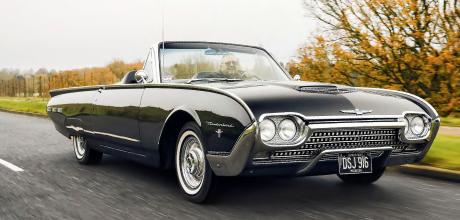1962 Ford Thunderbird
A scale-model Ford Thunderbird that Steve Richardson had as boy gave him a life-long yearning to try the real thing. Does it live up to the dream?
Words ANDREW NOAKES
Photography TONY BAKER
The List Your Dream Drive Made Real
Reader Steve Richardson gets to grips with a full-size Ford Thunderbird toy car
‘V8 burble, column shift – it’s a perfect piece of period Americana’
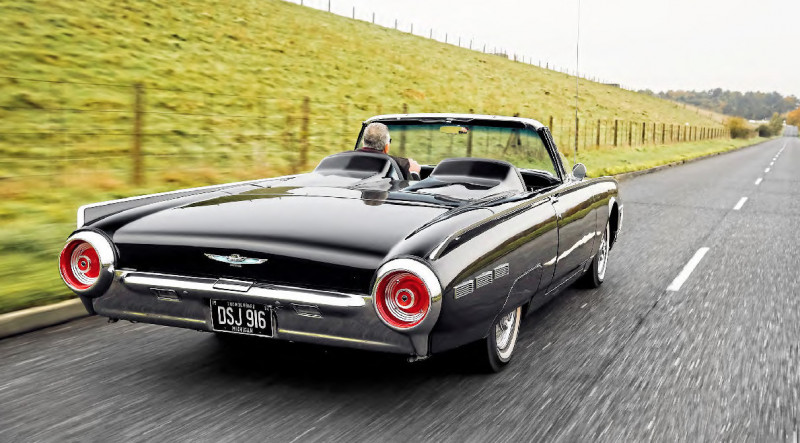
Kennedy and Khrushchev were facing off over nuclear missiles in Cuba, John Glenn was orbiting the Earth in Friendship 7, and a new beat group called The Beatles were taking the music charts by storm. It was 1962, and none of it mattered to one young petrolhead nearly as much as his brand new Corgi model of an impossibly glamorous Ford Thunderbird.
‘When you’re pulling away you can feel how much power the car has got’

Meanwhile an American serviceman stationed in Germany was placing an order for a Thunderbird of his own, a real one this time. Six decades later, we’re about to put Steve behind the super-sized steering wheel of that very car to find out if the real thing matches up to the hopes of a Corgi-wielding toddler. ‘It’s a car I always thought I’d love to have a drive in,’ he says. ‘When I was a kid all the space exploration was just starting off and the Thunderbird looked like a spaceship. I’ve always wondered if the experience of driving it matched up to that.’ We meet at a café in rural Essex and before long the unmistakable Bill Boyer-penned shape of a third-gen Thunderbird Convertible Sports Roadster cruises into view, with owner Kevin Moss at the controls.
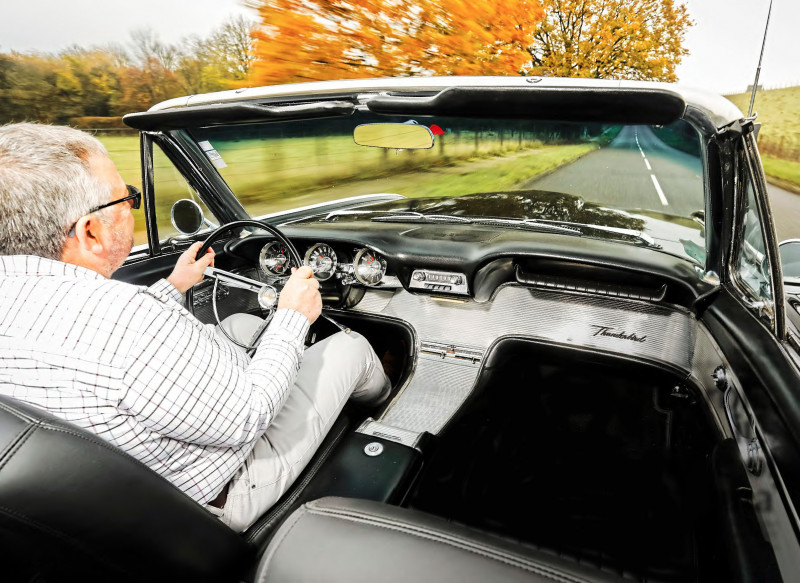
‘It’s an unusual car,’ says Kevin, matter-of-factly, once introductions have been made. ‘You drive down the street and people can’t tell what it is, though if you go to a show there will be people who are in the know.’ Steve’s already taking in the shape from its pointed four-headlamp nose to its jet nozzle rear lights. ‘It looks great even with the roof up, and I really love the colour,’ he says. Kevin’s Thunderbird started life as a ‘tripleblack’ car, meaning black bodywork, hood and interior, but at some point in its life it was repainted red and white. He has since restored it to its original colour scheme. ‘Most of the ones you see are brighter, brasher colours, but this really suits it.’
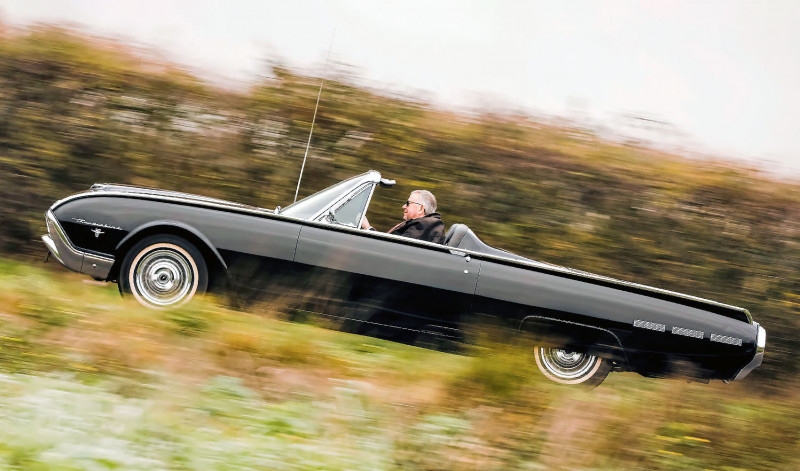
Steve says. ‘It makes the chrome stand out beautifully. Black always does that. These Thunderbirds often had an extra stainless steel trim along the body sides but that would be a bit much – the Americans always like that stuff but I prefer it without.’
More bling comes in the shape of the chrome-plated 5.5x14in Kelsey-Hayes wire wheels. ‘When they first came out the wheels had thinner spokes,’ Kevin explains. ‘Then they gave a car to Elvis Presley and he crashed it on the first day because he went round a bend and a rear wheel collapsed.’ Fortunately these are the later, thicker-spoke wheels. ‘It’s a big, heavy car for wire wheels,’ says Steve, ‘but they do look the part.’ The wheel covers are common on Thunderbirds but not usually fitted with these wheels. ‘I like the covers,’ Kevin says. ‘The only trouble is with the Kelsey-Hayes wheels they sometimes catch on the wheelarches.’
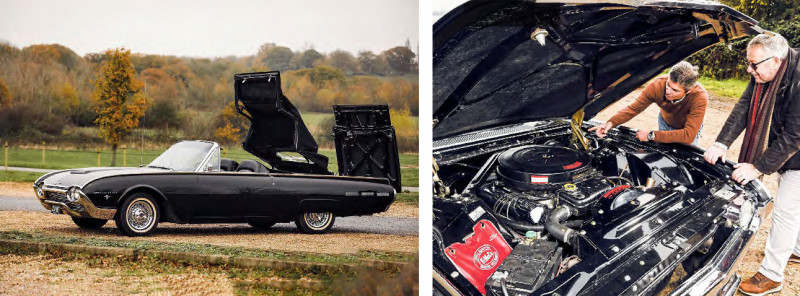
To give Steve the full Thunderbird experience Kevin drops the power-operated convertible top, an complex sequence of whirring, opening, folding, lowering, collapsing and closing, all coordinated by an array of electric motors and microswitches. ‘I was at a Knebworth show once when the sun came out, so I folded the roof down. It drew a crowd and I got a round of applause,’ Kevin grins as the hood does its thing. Steve watches in awe as the boot lid opens automatically to allow the roof to fold down into the ‘trunk’, where it takes up virtually all of the space available. ‘Good luck going away for the weekend with the roof down – you’d have to stash your luggage on the back seat.’
Dropping the hood reveals the removable double-humped glassfibre tonneau cover that makes the Sports Roadster look like a sleek two-seater when in fact it has space for four. ‘It’s a long time ago now but in my mind the Corgi toy Thunderbird I had was a Sports Roadster with the cover on,’ Steve remembers.
‘The details are really good on this car,’ he adds as he heads for the driving seat. ‘I love this door handle, and the way that it’s integrated into the trim along the side of the car. The line of the trim and the handle starts right at the front of the car and goes all the way along the side and down to the tail in one unbroken swoop. The whole car looks really clean because of that.’
Steve heaves open the massive left-hand door and settles into the driver’s seat for the first time. The door needs a good yank – as it were – to close properly because the door seal is brand new, and a gentle pull just results in it bouncing open again. ‘I had this with my E-type when it had new rubbers,’ says Steve. ‘You have to slam it and I don’t really like slamming car doors.’
Access to the interior is improved by a signature feature of the third-gen Thunderbird. ‘The Swing-Away steering wheel. That’s an interesting idea,’ says Steve. ‘When the gear selector is in Park, you can slide the steering column sideways towards the middle of the car giving you more space to get in and out.’ It was a $25 option when the model was introduced in 1961, and proved so popular it became part of the standard spec for ’62 cars like this one. ‘When I was about 15 a friend’s dad had an American car where the steering swung, and the seat turned too,’ Steve remembers. ‘It’s a great idea and makes it so much easier to get in and out, particularly with these huge steering wheels they always used at that time. It’s a shame the swinging wheel died out – I think it disappeared when they had to start fitting collapsible steering columns to meet crash safety regs.’ Steve settles into the individual leather seat, swings the steering wheel back into the running position and surveys the Thunderbird’s metal-clad dashboard and centre console.
‘There’s brushed aluminium everywhere,’ he remarks. ‘The way the dashboard sweeps round and joins up with the doors is superb. There’s more jet-age styling here too with these big round dials – fuel and temperature on the left, speed in the centre and the one on the right is a clock. They look terrific, and all the chrome switches are just fantastic.’
He twists the key in the ignition switch on the left of the dash and the big V8 engine rumbles into life. ‘You can’t beat a V8 burble,’ he grins. ‘There’s a column shift for the automatic gearbox too, of course – it’s just a perfect piece of period Americana.’ Though it only has two doors, and the cabin isn’t especially lavish on legroom, the Thunderbird takes up virtually the same amount of tarmac as a modern Mercedes S-Class saloon. That substantial size, plus left-hand drive, mean it’s a real handful in the narrow Essex lanes. ‘You sit quite close to the middle of the car and you can feel that there’s lots of bodywork outside you, on both sides,’ Steve says.
‘The steering wheel is close to your chest, and with this tonneau cover on you can’t push the seat any further back, so there isn’t much you can do about it. That’s a bit uncomfortable, but at least you don’t need to put any effort into the steering. It’s very light and low-geared, so there’s lots of twirling when you’re manoeuvring. It’s very smooth and easy, but there’s no feedback whatsoever. Based on other cars I’ve driven in the States I’d say it’s typically American steering. In fact because it’s so light, at first you find you turn the wheel too far in a corner, then you wind it back and find you’ve gone too far the other way and over-corrected. It certainly takes a bit of getting used to.’
On the open road Steve is impressed by the ride quality. ‘Like a lot of old cars it rides better than many moderns on their low-profile tyres,’ he says. ‘It just floats along beautifully, soaking up all the bumps without any problem at all. It would be great on A-roads or on the motorway – you could cover a lot of miles in it very comfortably.’
All up weight is well over two tonnes, but V8 power means the Thunderbird is quick enough not to be an embarrassment in today’s traffic. ‘When you’re pulling away you can feel how much power the car’s got,’ Steve says. ‘It surges away, sounds nice and feels really good. The auto gearbox is unobtrusive, too – you hear the engine note change occasionally but you can barely feel the gearchanges.’ After a few miles we stop for a look under the bonnet, marvelling at how engine and ancillaries easily fill the vast space. The 6.4-litre V8 is an all-iron engine, so by no means a lightweight. ‘It’s known as the FE engine,’ Kevin says drily. ‘I think the E stands for ’eavy.’
Though European performance cars were switching to disc brakes by 1962 they took longer to catch on Stateside, so it’s no surprise that the Thunderbird, despite its weight and power, relies on drums at all four corners. ‘They’re very wooden,’ Steve says. ‘It’s surprising how hard you have to push the pedal to get it to stop. When you’re going at a fair lick and you hit the brakes you’re wondering if it really is going to stop. But it’s not a problem, it’s just another characteristic you have to get used to.’
Steve’s expectations of the Thunderbird were based on a Corgi model and experiences with other American cars over the years. ‘It is what I thought it was going to be. It does look particularly good and the driving experience lives up to the looks, which is a relief. I’m very pleased with it, so it certainly keeps it place on my dream car list,’ he says. ‘I thought I was going to be more concerned about how big it is, but after a few miles it was fine. You easily learn to place it on the road.
The over-light steering is the Thunderbird’s biggest flaw, to European tastes at least. ‘But then, it is an essential part of that whole classic American car experience along with the big V8, the column change and the spectacular style inside and out,’ Steve says. ‘You see American cars on the road looking great, and you think they must just glide along. Well the Thunderbird delivers that. It would have been nice if the steering column adjusted so you could at least push the wheel a bit further away. I guess that slightly cramped driving position is the price you pay for the great styling feature of the double-humped tonneau cover, and I did get used to it quickly. I know the Sports Roadsters are hard to find, and Kevin says this one’s not for sale, but given a few bob to spare I’d be seriously tempted to buy one. I’ve always fancied having a big American car. But I’d need a bigger garage.’
Having acclimatised to the prodigal proportions, Steve says the Thunderbird keeps its place in his top ten
TECHNICAL DATA 1962 Ford Thunderbird
- Engine 6387cc V8, overhead valve, Ford/ Autolite 4100 four-choke carburettor
- Max Power 300bhp @ 4600rpm
- Max Torque 428lb ft @ 2800rpm
- Transmission Three-speed automatic, rear-wheel drive
- Steering Power-assisted recirculating ball
- Suspension Front: independent, wishbones, coil springs, telescopic dampers, anti-roll bar. Rear: live axle, semi-elliptic springs, telescopic dampers
- Brakes Vacuum boosted drums all round
- Performance Top speed: 125mph
- Acceleration 0-60mph: 8.5sec
- Weight 2100kg (4631lb)
- Fuel consumption 14mpg
- Cost new $5439 in 1962
- Classic Cars Price Guide £10,000-£22,000
Steve is eager to sample the 6.4 V8’s drive-defining 428lb ft Roof mechanism is a theatrical work of art
‘You sit close to the middle of the car; you can feel there’s lots of bodywork outside you’
Striking, but not the easiest to glean information from… Sixties bling mesmerised a young Steve Steve says the wheel is a bit of a space invader


